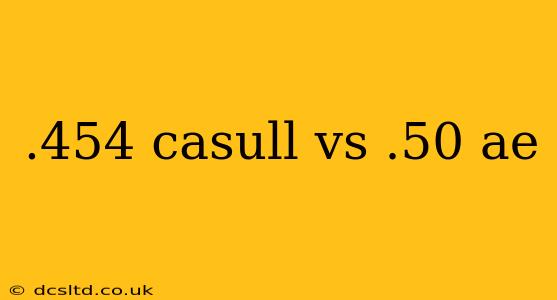The .454 Casull and the .50 AE represent the pinnacle of handgun power, captivating enthusiasts with their immense stopping power and thunderous recoil. Choosing between these behemoths requires a careful consideration of several factors, extending beyond simple bullet size. This in-depth comparison will explore their key differences and help you determine which cartridge best suits your needs.
What are the Key Differences Between the .454 Casull and .50 AE?
The most immediate difference lies in the cartridge's dimensions. The .50 AE (.50 Action Express) boasts a significantly larger diameter bullet (.50 caliber) compared to the .454 Casull (.454 caliber). This larger diameter translates to a substantially larger projectile, resulting in greater mass and, consequently, more energy upon impact. However, this advantage isn't without its trade-offs.
The .454 Casull, while using a smaller bullet, often achieves comparable or even superior velocity in certain loadings, compensating for its smaller diameter through higher muzzle energy. This is primarily due to the different case designs and powder capacities. The .454 Casull's longer, more capacious case allows for the use of more propellant, pushing lighter bullets to impressively high speeds.
Which Cartridge Has More Recoil?
The .50 AE generally exhibits more recoil than the .454 Casull, particularly in heavier-loaded rounds. While both cartridges deliver substantial recoil, the sheer size and mass of the .50 AE's bullet contribute significantly to felt recoil. The increased recoil of the .50 AE can make it less manageable for less experienced shooters, potentially impacting accuracy and follow-up shots.
Which is Better for Hunting?
Both cartridges are exceptionally potent for hunting, effectively taking down large game animals. The choice often depends on personal preference and the specific game being hunted.
-
.50 AE: Its massive stopping power makes it an excellent choice for very large game, but the heavy recoil may limit shot placement accuracy in demanding hunting situations.
-
.454 Casull: Its lighter recoil and higher velocity in some loads offer an advantage in terms of accuracy and faster follow-up shots, making it suitable for a broader range of hunting scenarios.
Which Cartridge is More Accurate?
Accuracy is influenced by multiple factors, including the firearm, ammunition, and shooter's skill. Generally, the .454 Casull is considered slightly more accurate due to its lighter recoil in many instances allowing for better shot placement. However, high-quality .50 AE handguns and ammunition can also deliver excellent accuracy.
What About Availability and Cost?
The .454 Casull generally has more widely available ammunition and reloading components than the .50 AE. While both are readily accessible to those who seek them, the .50 AE might be slightly more difficult to source in certain regions. Furthermore, the overall cost per round tends to be higher for the .50 AE due to the larger projectile.
Which is Better for Self-Defense?
Both cartridges possess exceptional stopping power, exceeding that of most standard self-defense calibers. However, the significant recoil of both cartridges poses a considerable challenge for self-defense scenarios. Precise shot placement under stress is critical, and the intense recoil could hinder the ability to deliver accurate follow-up shots. Consider the potential for overpenetration and the legal ramifications before choosing either caliber for self-defense.
Which is Easier to Shoot?
Without a doubt, the .454 Casull is generally considered easier to shoot due to its manageable (relatively speaking!) recoil. The .50 AE's significant recoil can be overwhelming for many shooters, particularly those with less experience with powerful handguns.
Ultimately, the decision between the .454 Casull and the .50 AE hinges on individual preferences, shooting experience, and intended use. Both are powerful and effective cartridges, but their distinct characteristics make them better suited to different applications. Thorough research, hands-on experience (if possible), and careful consideration of your needs are crucial before making a choice.
